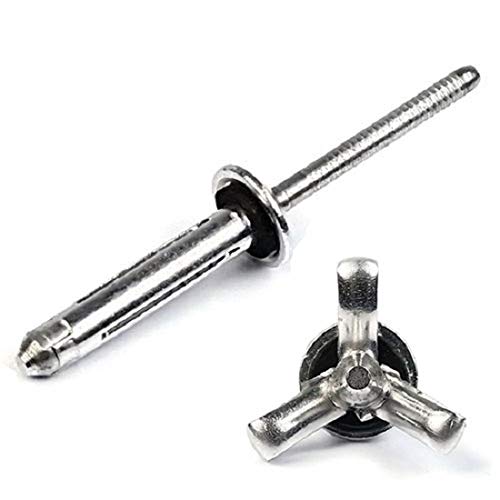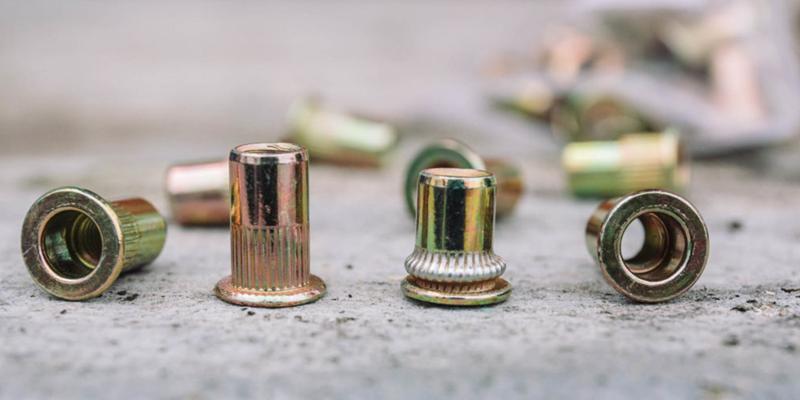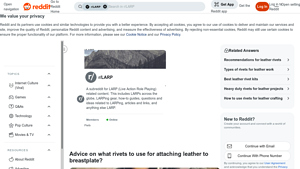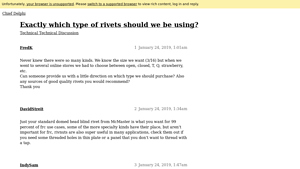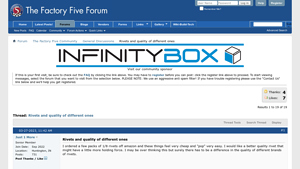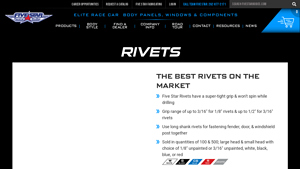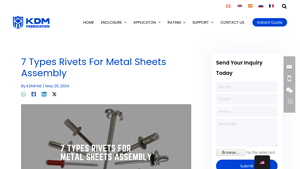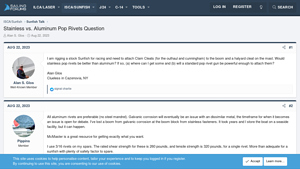Best Rivets Guide: Type, Cost, Top List…
Introduction: Navigating the Global Market for best rivets
In the increasingly competitive global market, sourcing the best rivets can present significant challenges for B2B buyers, especially those operating across diverse regions such as Africa, South America, the Middle East, and Europe. With a multitude of rivet types and applications available, selecting the right fastening solution requires a thorough understanding of specific needs, environmental factors, and material compatibility. This guide serves as a comprehensive resource, meticulously outlining the various types of rivets—including blind rivets, structural rivets, and specialty options—while detailing their respective applications, advantages, and limitations.
International buyers will benefit from insights on how to effectively vet suppliers to ensure quality and reliability, alongside considerations of cost and availability. Additionally, the guide offers practical advice on installation techniques and maintenance, empowering businesses to make informed purchasing decisions. By addressing common pain points and providing actionable insights, this resource equips B2B buyers with the knowledge needed to navigate the complexities of rivet sourcing and application, ultimately enhancing operational efficiency and product integrity in their respective industries.
Understanding best rivets Types and Variations
| Type Name | Key Distinguishing Features | Primary B2B Applications | Brief Pros & Cons for Buyers |
|---|---|---|---|
| Open End Rivets | Hollow body, available in multiple materials | Metal trim, lightweight installations | Pros: Cost-effective, versatile; Cons: Limited strength compared to closed-end rivets. |
| Closed End Rivets | Sealed end design, better shear and tensile strength | Waterproof applications, automotive, construction | Pros: Enhanced strength, reduces leakage; Cons: Higher cost, requires careful installation. |
| Multi-Grip Rivets | Extended material grip range, replaces multiple rivets | Variable thickness materials, manufacturing | Pros: Reduces inventory, versatile; Cons: May be overkill for thin materials. |
| Tri-Fold Rivets | Split body design for lightweight materials | Fiberglass, plastics, composite assembly | Pros: Minimal damage to materials, effective; Cons: Limited to lighter applications. |
| Peel Rivets | Body splits into petals upon installation | Soft materials like timber, rubber, and laminates | Pros: Large contact area, easy to use; Cons: Not suitable for heavy-duty applications. |
What are the Characteristics and Suitability of Open End Rivets?
Open end rivets, also known as pop rivets, are the most common type used in various applications due to their hollow design. They are available in materials like aluminum, steel, and stainless steel, making them versatile for different environments. Their primary use is in lightweight applications such as metal trim and general assembly tasks. When purchasing, buyers should consider the required strength and whether the application might benefit from a more robust alternative, as open end rivets may not provide the same level of durability as closed-end options.
How Do Closed End Rivets Enhance Performance in B2B Applications?
Closed end rivets feature a sealed design that helps prevent water ingress, making them ideal for applications where moisture resistance is crucial, such as in automotive and construction industries. They offer better shear and tensile strength compared to open end rivets, making them suitable for more demanding environments. When considering closed end rivets, buyers should evaluate the specific environmental conditions and potential exposure to moisture, as well as the cost implications of a stronger fastener.
Why Choose Multi-Grip Rivets for Variable Thickness Materials?
Multi-grip rivets are designed to accommodate a wide range of material thicknesses, making them an excellent choice for applications where the materials being joined may vary in depth. This flexibility can simplify inventory management by reducing the number of different rivets needed on hand. For buyers, the key consideration is ensuring that the multi-grip rivet’s strength is suitable for the application, as they provide superior performance compared to standard open end rivets.
What Are the Advantages of Using Tri-Fold Rivets in Lightweight Assemblies?
Tri-fold rivets feature a unique split design that forms a propeller shape anchor on the blind side, which is particularly effective for joining lightweight materials like fiberglass and plastics. This design minimizes damage to the materials being fastened, making them ideal for delicate assemblies. Buyers should consider the weight and type of materials being joined, as tri-fold rivets are not suitable for heavy-duty applications.
How Do Peel Rivets Provide Solutions for Soft Material Assemblies?
Peel rivets are specifically designed for joining softer materials such as timber, rubber, and laminates. Upon installation, the rivet body splits into petals, creating a large contact area that enhances the joint’s strength. For B2B buyers, the ease of use and effectiveness in creating strong connections in soft materials are significant advantages; however, these rivets are not recommended for heavy-duty applications, making it essential to assess the material requirements before selection.
Key Industrial Applications of best rivets
| Industry/Sector | Specific Application of best rivets | Value/Benefit for the Business | Key Sourcing Considerations for this Application |
|---|---|---|---|
| Automotive | Joining body panels and structural components | Ensures durability and safety of vehicles | Material compatibility, corrosion resistance, size |
| Construction | Fixing metal framing and roofing systems | Provides strong, permanent connections under load | Load-bearing capacity, weather resistance, size |
| Aerospace | Securing aircraft components and assemblies | Meets stringent safety standards and weight requirements | Certification, material specifications, reliability |
| Electronics | Assembling circuit boards and enclosures | Facilitates efficient production and assembly processes | Size, electrical conductivity, environmental factors |
| Furniture Manufacturing | Attaching components in metal and wood furniture | Enhances product durability and aesthetic appeal | Material compatibility, finish options, size |
How Are Best Rivets Used in the Automotive Industry?
In the automotive sector, best rivets are crucial for joining body panels and structural components. They provide a strong, reliable bond that is essential for vehicle safety and durability. Rivets are particularly advantageous in scenarios where welding is impractical due to accessibility or the need for dissimilar material joining. For international buyers, sourcing rivets that meet local safety regulations and are resistant to corrosion is vital, especially in regions with varying climates.
What Role Do Best Rivets Play in Construction?
Best rivets are extensively used in construction for fixing metal framing and roofing systems. Their ability to provide strong, permanent connections under load makes them ideal for structural applications. This is particularly important in regions prone to extreme weather conditions, where stability is paramount. Buyers must consider factors such as load-bearing capacity and weather resistance when sourcing rivets, ensuring they meet the specific requirements of their projects.
Why Are Best Rivets Important in Aerospace Applications?
In the aerospace industry, best rivets are employed to secure aircraft components and assemblies, adhering to stringent safety standards. The lightweight yet strong nature of rivets is critical for maintaining the overall efficiency and performance of aircraft. International buyers should focus on sourcing certified rivets that comply with aerospace material specifications to ensure reliability and safety in their applications.
How Are Best Rivets Utilized in Electronics Manufacturing?
Best rivets are integral to assembling circuit boards and enclosures in the electronics industry. They facilitate efficient production and assembly processes by providing a secure fastening solution that minimizes the risk of damage to sensitive components. Buyers should prioritize rivets that offer appropriate sizes and electrical conductivity, as well as those that can withstand environmental factors like humidity and temperature fluctuations.
What Benefits Do Best Rivets Offer in Furniture Manufacturing?
In furniture manufacturing, best rivets are used to attach components in metal and wood furniture, enhancing both durability and aesthetic appeal. They allow for a clean finish without visible fasteners, which is often a design requirement. When sourcing rivets for furniture applications, compatibility with different materials and finish options are key considerations for international buyers, ensuring that the final product meets market expectations and quality standards.
3 Common User Pain Points for ‘best rivets’ & Their Solutions
Scenario 1: Selecting the Right Rivet for Specific Applications
The Problem: B2B buyers often struggle with selecting the appropriate type of rivet for their specific application. With a myriad of options available—such as blind rivets, closed-end rivets, and multi-grip rivets—the wrong choice can lead to project delays, increased costs, and compromised structural integrity. For instance, using a standard blind rivet in a high-moisture environment could result in rusting and failure, while a closed-end rivet might be necessary for waterproof applications. Buyers may find themselves overwhelmed by technical specifications, leading to hesitation and indecision.
The Solution: To overcome this challenge, buyers should begin by conducting a thorough needs assessment based on the application environment, materials involved, and load requirements. Create a checklist that includes factors like the thickness of materials, whether the rivets will be exposed to moisture or corrosive substances, and the required strength of the joint. Once the criteria are established, consult with a reputable supplier who can provide technical data sheets and guidance on the best rivet types suited for specific applications. Engaging in direct communication with suppliers can also facilitate better understanding and insight into the latest products available, ensuring that the right rivet is selected for the job. Additionally, consider investing in rivet selection software or tools that can assist in making informed decisions based on the parameters you define.
Scenario 2: Managing Inventory and Stock Levels
The Problem: Many businesses face difficulties in managing inventory levels for rivets, especially when dealing with various types and sizes. Over-ordering can lead to excess stock, tying up capital, while under-ordering can cause project delays due to shortages. This is particularly challenging for companies operating in regions with longer lead times, like parts of Africa and South America, where procurement processes can be complicated by logistical issues.
The Solution: To effectively manage rivet inventory, businesses should implement a just-in-time (JIT) inventory system. Start by analyzing historical usage data to identify trends and peak demand periods. Create a forecasting model based on this data to predict future needs accurately. Establish relationships with multiple suppliers to ensure flexibility and quick replenishment of stock when necessary. By utilizing inventory management software, buyers can automate re-ordering processes and maintain optimal stock levels without over-committing resources. Additionally, consider setting up a consignment inventory agreement with suppliers, where they maintain stock on-site until it is used, allowing for greater flexibility and reduced holding costs.
Scenario 3: Ensuring Quality and Compliance with Standards
The Problem: For B2B buyers, ensuring that rivets meet specific quality standards and compliance requirements is paramount, especially in industries such as automotive and aerospace. Poor-quality rivets can lead to catastrophic failures, posing safety risks and resulting in costly recalls or repairs. Buyers may find it difficult to verify the quality and certifications of rivets, particularly when sourcing from international suppliers.
The Solution: To mitigate this risk, buyers should adopt a rigorous supplier qualification process that includes verifying certifications, quality control measures, and compliance with international standards such as ISO 9001. Request samples and conduct thorough testing to assess performance against the required specifications. Establish a clear communication channel with suppliers to discuss quality expectations and inspection protocols. Additionally, consider partnering with third-party testing laboratories to conduct independent assessments of rivet quality before making bulk purchases. Regularly audit supplier practices to ensure ongoing compliance and quality assurance. By prioritizing quality control and compliance, businesses can enhance their operational reliability and safeguard against potential liabilities.
Strategic Material Selection Guide for best rivets
What Are the Key Properties of Common Rivet Materials?
When selecting rivets for various applications, understanding the properties of different materials is crucial. Here, we analyze four common materials used in rivet manufacturing: aluminum, stainless steel, carbon steel, and plastic. Each material has unique characteristics that influence its performance, durability, and suitability for specific applications.
How Does Aluminum Perform as a Rivet Material?
Aluminum rivets are lightweight and exhibit excellent corrosion resistance, making them ideal for applications in marine environments and other outdoor settings. They typically have a temperature rating of up to 150°C and are suitable for low-pressure applications.
Pros: Aluminum rivets are easy to install and provide a good strength-to-weight ratio. They are also cost-effective, which is beneficial for large-scale projects.
Cons: While durable, aluminum rivets may not withstand high-stress environments or extreme temperatures as well as other materials. They also have lower tensile strength compared to stainless steel.
Impact on Application: Aluminum rivets are commonly used in automotive, aerospace, and construction industries where weight savings are critical.
Considerations for International Buyers: Compliance with international standards such as ASTM and DIN is essential. Buyers should also consider the availability of aluminum rivets in their region, particularly in developing markets like Africa and South America.
What Advantages Do Stainless Steel Rivets Offer?
Stainless steel rivets, particularly those made from ISO 304 or 316 grades, are known for their exceptional strength and corrosion resistance, making them suitable for harsh environments, including marine and chemical applications. They can typically withstand temperatures up to 300°C.
Pros: The primary advantage of stainless steel rivets is their durability and resistance to rust and corrosion. They are ideal for applications requiring long-term reliability.
Cons: The cost of stainless steel rivets is generally higher than that of aluminum or carbon steel, which may impact budget-sensitive projects. Additionally, they can be more challenging to install due to their hardness.
Impact on Application: Stainless steel rivets are often used in structural applications, automotive manufacturing, and outdoor installations where exposure to moisture is a concern.
Considerations for International Buyers: Buyers should verify compliance with local standards and regulations, especially in regions with strict quality control measures. The higher cost may also necessitate a thorough cost-benefit analysis.
What Are the Benefits of Using Carbon Steel Rivets?
Carbon steel rivets are known for their strength and are often used in heavy-duty applications. They typically have a temperature rating of up to 200°C and can handle high-pressure environments.
Pros: These rivets are cost-effective and provide excellent tensile strength, making them suitable for structural applications.
Cons: Carbon steel rivets are prone to corrosion if not properly treated or coated, which can limit their use in outdoor or humid environments.
Impact on Application: Commonly used in construction and heavy machinery, carbon steel rivets are ideal for projects where strength is prioritized over corrosion resistance.
Considerations for International Buyers: Buyers should ensure that carbon steel rivets meet local standards for strength and corrosion resistance, especially in regions with varying climates.
How Do Plastic Rivets Compare in Performance?
Plastic rivets are lightweight and resistant to corrosion, making them suitable for applications where metal rivets may not be appropriate, such as in electronic devices or in environments where electrical conductivity must be minimized.
Pros: They are easy to install and can be used in applications that require insulation from heat and electricity.
Cons: Plastic rivets generally have lower strength compared to metal rivets and may not perform well under high-stress or high-temperature conditions.
Impact on Application: Plastic rivets are commonly used in electronics, automotive interiors, and lightweight assemblies.
Considerations for International Buyers: While plastic rivets may be less regulated than metal options, buyers should still ensure compliance with relevant standards, especially in electronics and automotive sectors.
Summary Table of Rivet Materials
| Material | Typical Use Case for best rivets | Key Advantage | Key Disadvantage/Limitation | Relative Cost (Low/Med/High) |
|---|---|---|---|---|
| Aluminum | Automotive and aerospace applications | Lightweight and corrosion-resistant | Lower tensile strength than steel | Low |
| Stainless Steel | Structural and outdoor applications | High durability and corrosion resistance | Higher cost and installation difficulty | High |
| Carbon Steel | Construction and heavy machinery | Excellent tensile strength | Prone to corrosion without treatment | Medium |
| Plastic | Electronics and lightweight assemblies | Insulation from heat and electricity | Lower strength under stress | Low |
This comprehensive analysis provides B2B buyers with actionable insights into the material selection process for rivets, helping them make informed decisions based on their specific application needs.
In-depth Look: Manufacturing Processes and Quality Assurance for best rivets
What Are the Key Stages in the Manufacturing Process of Rivets?
The manufacturing of rivets involves several critical stages, each essential for ensuring the quality and performance of the final product.
Material Preparation: How Is Raw Material Selected and Prepared?
The first step in the rivet manufacturing process is selecting the appropriate raw materials. Common materials include various grades of steel, aluminum, and stainless steel, chosen based on the intended application of the rivets. For instance, stainless steel is preferred for outdoor applications due to its corrosion resistance.
Once the material is selected, it undergoes cutting and shaping. This involves cutting the raw material into specific lengths and diameters to meet design specifications. The preparation stage may also include processes like annealing to enhance ductility, ensuring the material can be easily formed without cracking.
Forming: What Techniques Are Used to Shape Rivets?
The forming stage is where the rivet takes shape. This can involve several techniques, including:
-
Cold Heading: A process where the material is shaped at room temperature, providing a high-strength product without compromising material integrity. Cold heading is often used for the body of the rivet.
-
Hot Forging: For larger or more complex rivets, hot forging may be employed. This involves heating the metal to a high temperature before shaping it, allowing for greater flexibility in design.
-
Roll Forming: This technique is used to create specific profiles and is often used for specialized rivets such as multi-grip or tri-fold rivets.
After forming, the rivets are typically trimmed to ensure uniformity in length.
Assembly: How Are Rivets Assembled and Prepared for Distribution?
In the assembly phase, the rivet components—the body and the mandrel—are brought together. For blind rivets, the mandrel is longer than the body, allowing it to be pulled through during installation, expanding the rivet body to secure the materials being joined.
Automated assembly lines are commonly used for high-volume production, ensuring precision and consistency. Quality control measures are implemented at this stage to ensure that each rivet meets the required specifications before moving on to the finishing process.
Finishing: What Processes Ensure Rivets Meet Quality Standards?
The finishing stage can involve several treatments, including:
-
Surface Treatment: Processes such as anodizing, plating, or painting enhance corrosion resistance and aesthetic appeal. This is particularly important for rivets used in visible applications, such as automotive or architectural installations.
-
Packaging: After finishing, rivets are sorted, packaged, and labeled according to customer specifications. Proper packaging is crucial for maintaining product integrity during shipping and storage.
What Quality Assurance Measures Are Essential for Rivet Manufacturing?
Quality assurance (QA) is a vital part of the rivet manufacturing process, ensuring that the final products meet both international standards and customer expectations.
Which International Standards Should B2B Buyers Consider?
International standards such as ISO 9001 are crucial for ensuring a consistent quality management system. This certification indicates that the manufacturer has established processes for continuous improvement and customer satisfaction.
In addition to ISO standards, industry-specific certifications like CE marking for products sold in Europe and API specifications for the oil and gas industry can enhance credibility. These certifications demonstrate compliance with safety and performance standards critical for applications in various sectors.
What Are the Key Quality Control Checkpoints in Rivet Production?
Quality control (QC) in rivet manufacturing typically includes several checkpoints:
-
Incoming Quality Control (IQC): This involves inspecting raw materials upon arrival to ensure they meet specified standards before production begins.
-
In-Process Quality Control (IPQC): During manufacturing, random samples are tested for dimensions, strength, and finish. This continuous monitoring helps identify issues early in the process.
-
Final Quality Control (FQC): Once production is complete, a final inspection ensures that the rivets meet all specifications and standards. This may involve destructive and non-destructive testing methods, such as tensile strength tests or visual inspections.
How Can B2B Buyers Verify Supplier Quality Assurance?
For B2B buyers, verifying a supplier’s quality assurance practices is essential to ensure reliability and performance. Here are some methods to achieve this:
-
Supplier Audits: Conducting on-site audits of potential suppliers can provide insight into their manufacturing processes, quality control measures, and adherence to international standards.
-
Quality Reports: Requesting detailed quality reports, including testing results and compliance certifications, can help buyers assess a supplier’s capabilities.
-
Third-Party Inspections: Engaging third-party inspection services can offer an unbiased evaluation of a supplier’s products and processes, further ensuring quality.
What Nuances Should International Buyers Be Aware Of?
International buyers, particularly those from regions like Africa, South America, the Middle East, and Europe, should be aware of specific nuances in quality assurance. This includes understanding regional standards and certifications, potential language barriers in documentation, and varying levels of regulatory compliance among suppliers.
Additionally, considering logistics and shipping challenges can affect lead times and product integrity. Establishing clear communication channels and understanding local practices can help mitigate these challenges.
Conclusion: Why Is a Robust Manufacturing and QC Process Vital for Rivet Procurement?
In summary, a comprehensive understanding of the manufacturing processes and quality assurance measures for rivets is crucial for B2B buyers. By prioritizing suppliers that adhere to international standards and implement rigorous quality control measures, businesses can ensure they receive reliable and high-quality products tailored to their specific applications. This diligence not only enhances product performance but also builds long-term partnerships in the global supply chain.
Practical Sourcing Guide: A Step-by-Step Checklist for ‘best rivets’
The following checklist serves as a practical guide for B2B buyers looking to procure the best rivets for their specific needs. By following these steps, you can ensure that you make informed decisions that align with your project requirements and business objectives.
Step 1: Define Your Technical Specifications
Understanding your technical requirements is fundamental. Determine the materials you will be joining, the environmental conditions they will face, and the specific performance characteristics needed, such as tensile strength and corrosion resistance. This clarity will guide your choice of rivet type, whether it’s blind rivets, structural rivets, or specialty rivets.
Step 2: Identify the Right Rivet Type for Your Application
Different applications require different rivet types. For instance, consider whether you need open-end rivets for general use or closed-end rivets for moisture-sensitive areas. Evaluate options like multi-grip rivets for varied material thicknesses or peel rivets for softer materials. Understanding the nuances can significantly impact the effectiveness of your joint.
Step 3: Evaluate Potential Suppliers
Before committing, it’s crucial to vet suppliers thoroughly. Request company profiles, case studies, and references from buyers in a similar industry or region. Key factors to consider include:
– Quality Assurance: Look for suppliers with established quality control processes.
– Certifications: Ensure they meet industry standards relevant to your application, such as ISO certifications.
Step 4: Assess Material Quality and Compatibility
The material of the rivets is critical to their performance. Assess whether you need stainless steel for outdoor applications or aluminum for lightweight projects. Additionally, consider compatibility with the materials being joined to avoid issues like galvanic corrosion. Supplier specifications should clearly indicate the material grades and properties.
Step 5: Check for Customization Options
If your project has unique requirements, inquire about customization capabilities. Some suppliers offer tailored solutions, such as specific sizes, colors, or coatings that can enhance performance or aesthetics. Customization can help streamline inventory management by allowing you to stock fewer standard sizes.
Step 6: Review Pricing and Payment Terms
Understanding the total cost of ownership is essential. Compare pricing across different suppliers while factoring in shipping costs, bulk discounts, and payment terms. Ensure you have a clear understanding of any additional fees to avoid unexpected expenses.
Step 7: Establish a Clear Communication Channel
Effective communication with your supplier can prevent misunderstandings and streamline the procurement process. Set expectations for response times and establish a point of contact for technical questions or issues. Regular updates regarding order status can also help in maintaining project timelines.
By following this checklist, you can systematically approach your rivet procurement process, ensuring that you select the best products that meet your needs while fostering strong supplier relationships.
Comprehensive Cost and Pricing Analysis for best rivets Sourcing
What Are the Key Cost Components in Rivet Sourcing?
When sourcing rivets, understanding the cost structure is essential for B2B buyers. The primary cost components include:
-
Materials: The choice of materials significantly impacts pricing. Common materials include aluminum, stainless steel, and carbon steel. Higher-grade materials, such as ISO 304 stainless steel, are generally more expensive due to their durability and corrosion resistance.
-
Labor: Labor costs vary by region and manufacturing process. In countries with lower labor costs, such as Vietnam, manufacturers may offer competitive pricing, but this can also affect quality and delivery times.
-
Manufacturing Overhead: This encompasses costs related to factory operations, such as utilities, equipment maintenance, and administrative expenses. Efficient manufacturing processes can help lower overhead costs, which may translate to better pricing for buyers.
-
Tooling: The initial investment in tooling for specialized rivet production can be significant. Custom tools for unique rivet designs or sizes may lead to higher upfront costs but can offer long-term savings through improved production efficiency.
-
Quality Control (QC): Rigorous QC processes ensure that rivets meet industry standards. This may include testing for tensile strength and corrosion resistance. Enhanced QC practices can increase costs but are crucial for ensuring product reliability.
-
Logistics: Transportation and warehousing costs vary based on the supplier’s location and the buyer’s destination. International shipping, customs duties, and tariffs can add to the total cost, particularly for buyers in Africa and South America.
-
Margin: Suppliers typically apply a margin based on their operational costs, market demand, and competitive landscape. Buyers should be aware that margins can vary significantly between manufacturers.
What Influences Rivet Pricing in B2B Transactions?
Several factors influence the pricing of rivets in B2B transactions:
-
Volume/MOQ: Bulk orders often lead to lower per-unit costs. Suppliers may offer discounts for larger Minimum Order Quantities (MOQs), making it essential for buyers to assess their needs accurately.
-
Specifications and Customization: Custom rivets tailored to specific applications can incur additional costs. Buyers should provide detailed specifications to avoid misunderstandings that could lead to increased expenses.
-
Material Quality and Certifications: Rivets that meet specific industry standards or certifications (such as ISO or ASTM) tend to have a higher price. Buyers should weigh the importance of these certifications against their budget.
-
Supplier Factors: The reputation, reliability, and geographic location of the supplier can impact pricing. Established suppliers may charge a premium for their experience and quality assurance.
-
Incoterms: The choice of Incoterms (International Commercial Terms) affects shipping costs and responsibilities. Buyers should understand these terms to prevent unexpected expenses during the delivery process.
How Can Buyers Effectively Negotiate Rivet Prices?
Effective negotiation strategies can help buyers secure better pricing on rivets:
-
Conduct Market Research: Understanding current market prices and trends allows buyers to make informed negotiations. Knowledge of competing suppliers can strengthen bargaining positions.
-
Emphasize Long-Term Relationships: Building a strong relationship with suppliers may lead to better pricing and terms. Suppliers are often more willing to negotiate with clients who demonstrate loyalty and consistent orders.
-
Consider Total Cost of Ownership (TCO): Evaluate not just the purchase price but the total cost of ownership, including installation, maintenance, and potential failure costs. A lower initial price may not always translate to overall savings.
-
Explore Alternative Suppliers: Diversifying the supplier base can lead to competitive pricing and reduced dependency on a single source. This is particularly beneficial in regions like Africa and South America, where market dynamics can vary.
What Should International Buyers Keep in Mind When Sourcing Rivets?
For international B2B buyers, especially from Africa, South America, the Middle East, and Europe, understanding regional nuances is crucial:
-
Currency Fluctuations: Currency exchange rates can significantly impact costs. Buyers should factor this into their budgets and consider locking in rates when feasible.
-
Import Regulations and Tariffs: Familiarize yourself with local import regulations, tariffs, and taxes that could affect the overall cost of rivets. This is especially relevant for countries with stringent trade policies.
-
Cultural Considerations: Building rapport and understanding cultural norms can facilitate smoother negotiations and transactions. Buyers should invest time in understanding their suppliers’ business practices.
Disclaimer on Pricing
Pricing for rivets is subject to fluctuation based on market conditions, material availability, and manufacturing costs. The information provided serves as a general guideline and may not reflect current market prices. Buyers are encouraged to obtain quotes from multiple suppliers to ensure they receive competitive pricing tailored to their specific needs.
Alternatives Analysis: Comparing best rivets With Other Solutions
Introduction: Exploring Alternatives to Best Rivets
In the fast-evolving landscape of industrial fastening solutions, B2B buyers often seek alternatives to traditional rivets. While rivets provide unique advantages in terms of strength and ease of use, other fastening technologies may better suit specific applications or requirements. This section compares the most effective rivets with alternative methods such as adhesive bonding and welding, allowing buyers to make informed decisions based on their unique needs.
Comparison Table
| Comparison Aspect | Best Rivets | Adhesive Bonding | Welding |
|---|---|---|---|
| Performance | Strong, permanent joints; versatile for various materials | Good for dissimilar materials; flexible but may not be as strong | Extremely strong bonds; ideal for metals |
| Cost | Generally low-cost and economical | Variable; depends on material and type | Higher initial costs; equipment and labor-intensive |
| Ease of Implementation | Quick installation; requires minimal training | Requires surface preparation; curing time may vary | Requires skilled labor and specific equipment |
| Maintenance | Low maintenance; easy to inspect | May require reapplication over time | Permanent once set; can be costly to repair |
| Best Use Case | Sheet metal, composites, outdoor applications | Lightweight materials, sensitive components | Heavy-duty applications, structural integrity |
Detailed Breakdown of Alternatives
Adhesive Bonding: When Is It Beneficial?
Adhesive bonding utilizes various types of adhesives to join materials together. This method excels in applications involving dissimilar materials, such as metal to plastic, where traditional rivets may fail. Adhesives can also provide excellent stress distribution, reducing the likelihood of material fatigue. However, the performance of adhesive bonds can be affected by environmental conditions, such as temperature and humidity. Additionally, surface preparation is critical for achieving a strong bond, and curing times can delay production processes. While adhesives may prove economical for certain applications, they may require reapplication over time, leading to increased long-term costs.
Welding: Is It the Right Choice for Your Needs?
Welding is a robust fastening method that creates a permanent bond by melting the base materials. It is particularly effective for heavy-duty applications, such as structural steel construction or automotive manufacturing. Welding provides exceptional strength and durability, making it ideal for high-stress environments. However, it necessitates skilled labor and specialized equipment, resulting in higher initial costs and longer lead times. Moreover, welded joints may require additional finishing processes to ensure aesthetics and prevent corrosion. For projects that demand structural integrity and high strength, welding remains a superior choice, albeit with a greater investment in terms of time and resources.
Conclusion: Choosing the Right Fastening Solution
When selecting the appropriate fastening solution for your project, consider the unique requirements of your application, including material types, environmental conditions, and budget constraints. While best rivets offer a reliable and cost-effective option for many applications, alternatives like adhesive bonding and welding may provide distinct advantages in specific scenarios. By evaluating performance, cost, ease of implementation, maintenance, and best use cases, B2B buyers can make informed decisions that align with their operational goals and project specifications. Ultimately, the right choice will depend on a careful analysis of the specific needs and constraints of each unique project.
Essential Technical Properties and Trade Terminology for best rivets
When selecting the best rivets for your application, understanding the essential technical properties and industry terminology is crucial for making informed decisions. This section outlines the critical specifications and common jargon that every B2B buyer should be familiar with to streamline their procurement process.
What Are the Key Technical Properties of Rivets?
1. Material Grade
The material used in rivets significantly affects their performance and durability. Common materials include aluminum, stainless steel (ISO 304 and 316), and steel. Aluminum rivets are lightweight and corrosion-resistant, making them ideal for applications in moist environments. Stainless steel rivets offer superior strength and longevity, especially in outdoor settings. Understanding material grades ensures that you choose rivets that can withstand specific environmental conditions and mechanical stresses.
2. Grip Range
Grip range refers to the thickness of the materials that a rivet can effectively join. It is essential to match the rivet’s grip range with the combined thickness of the materials being fastened. Using a rivet with an incorrect grip range can lead to weak joints or structural failures. For instance, a rivet with a specified grip range of 4-7 mm will not adequately secure materials thicker than 7 mm.
3. Shear Strength
Shear strength is the maximum load a rivet can withstand before it fails due to shearing forces. This property is crucial in applications where rivets are subjected to lateral forces. Selecting rivets with appropriate shear strength ensures that the assembly maintains integrity under operational loads, especially in industries such as automotive and aerospace.
4. Tensile Strength
Tensile strength indicates the maximum amount of tensile (pulling) stress a rivet can handle before breaking. Like shear strength, this property is vital for assessing the rivet’s performance in various applications. A rivet with high tensile strength is essential in constructions where the joint may experience stretching or pulling forces.
5. Corrosion Resistance
Corrosion resistance is particularly important for rivets used in outdoor or harsh environments. Selecting rivets made from corrosion-resistant materials, such as stainless steel or specially coated options, helps to prolong the lifespan of the assembly and reduce maintenance costs.
What Are Common Trade Terms in the Rivet Industry?
1. OEM (Original Equipment Manufacturer)
OEM refers to companies that produce parts or equipment that may be marketed by another manufacturer. In the context of rivets, understanding OEM specifications is vital for ensuring compatibility with existing products and systems.
2. MOQ (Minimum Order Quantity)
MOQ is the smallest number of units a supplier is willing to sell. This term is critical for procurement planning, as it can influence inventory costs and order frequency. Knowing the MOQ helps buyers manage their budgets and stock levels effectively.
3. RFQ (Request for Quotation)
An RFQ is a document sent to suppliers requesting pricing and terms for specific products or services. In the rivet industry, issuing an RFQ enables buyers to compare prices, delivery times, and terms from different suppliers, facilitating better decision-making.
4. Incoterms (International Commercial Terms)
Incoterms are internationally recognized rules that define the responsibilities of buyers and sellers in international transactions. Familiarity with Incoterms is essential for understanding shipping terms, risk management, and cost allocation during the procurement process.
5. Blind Rivet
A blind rivet, often called a pop rivet, is a type of fastener that can be installed from one side of the material. This feature makes them ideal for applications where access to both sides is limited. Knowing the differences between blind and other types of rivets aids in selecting the right fastener for specific projects.
By understanding these essential technical properties and industry terms, B2B buyers can make more informed purchasing decisions, ensuring that they select the best rivets for their specific applications.
Navigating Market Dynamics and Sourcing Trends in the best rivets Sector
What Are the Key Market Dynamics Influencing the Rivets Sector?
The global rivets market is experiencing significant growth, driven by increasing demand across various sectors, including automotive, aerospace, construction, and electronics. The rise of manufacturing in developing regions, particularly in Africa and South America, is creating lucrative opportunities for international B2B buyers. In addition, the shift towards lightweight materials in industries like automotive and aerospace is propelling the need for advanced rivet technologies, including multi-grip and closed-end rivets.
Emerging technologies, such as automation and digital supply chain management, are reshaping how companies source rivets. B2B buyers are increasingly leveraging e-commerce platforms and online marketplaces to streamline procurement processes, reduce lead times, and gain access to a broader array of products. Additionally, advanced data analytics is being utilized to forecast demand and optimize inventory management, allowing buyers to make more informed purchasing decisions.
Furthermore, sustainability is becoming a key consideration in sourcing strategies. Buyers are now prioritizing suppliers who adhere to environmental regulations and offer eco-friendly rivet options, such as those made from recycled materials. As international trade continues to evolve, understanding regional preferences and regulatory landscapes will be crucial for B2B buyers to navigate the complexities of the rivets market effectively.
How Are Sustainability and Ethical Sourcing Shaping Rivet Procurement?
In today’s market, sustainability and ethical sourcing are not just trends but critical components of responsible business practices. The production of rivets can have significant environmental impacts, from resource extraction to manufacturing processes. As a result, B2B buyers are increasingly seeking suppliers who demonstrate a commitment to sustainability. This includes sourcing rivets made from recycled materials, such as stainless steel and aluminum, which minimize resource consumption and waste.
Moreover, ethical supply chains are gaining importance, with businesses aiming to ensure fair labor practices and transparency throughout their sourcing processes. Buyers are encouraged to look for suppliers who hold certifications like ISO 14001, which signifies an organization’s commitment to environmental management. These certifications can provide assurance that the materials used in rivet production adhere to high environmental and ethical standards.
Incorporating ‘green’ materials into procurement strategies not only meets consumer demand for sustainability but can also lead to cost savings in the long run. By opting for eco-friendly rivets, companies can enhance their brand reputation and appeal to a growing market segment that prioritizes sustainability in purchasing decisions.
How Has the Rivets Sector Evolved Over Time?
The evolution of the rivets sector is marked by significant technological advancements and changing market needs. Initially, rivets were primarily used in heavy industrial applications, such as shipbuilding and bridge construction. However, as manufacturing processes evolved, so did the design and application of rivets. The introduction of blind rivets revolutionized the industry by allowing for one-sided assembly, thus simplifying installation in hard-to-reach areas.
In recent years, the focus has shifted towards lightweight, high-strength materials, driven by the demand for efficiency and performance in various applications, including aerospace and automotive manufacturing. This shift has led to the development of specialized rivet types, such as multi-grip and tri-fold rivets, which cater to specific needs in joining dissimilar materials.
As environmental concerns have gained prominence, the industry has also seen a rise in the production of sustainable rivets, with manufacturers increasingly adopting eco-friendly practices. This evolution reflects the broader trends in global manufacturing, where innovation, sustainability, and ethical considerations are becoming essential for success in the competitive B2B landscape.
Frequently Asked Questions (FAQs) for B2B Buyers of best rivets
-
How do I select the right rivets for my project?
Selecting the right rivets involves considering several factors, including the materials you are joining, the environment they will be used in, and the load requirements. Start by determining the grip range, which is the total thickness of the materials. Choose rivets made from materials like stainless steel for outdoor applications or waterproof rivets for moisture-prone areas. Additionally, assess the rivet type—blind rivets are ideal for one-sided access, while structural rivets provide enhanced strength for heavy-duty applications. -
What is the best type of rivet for automotive applications?
For automotive applications, stainless steel blind rivets are often the best choice due to their durability and resistance to rust. They provide a strong join and can withstand outdoor conditions. Multi-grip rivets are also popular, as they accommodate varying material thicknesses, which is common in vehicle assemblies. Consider using coloured blind rivets if aesthetics are important, as they can match vehicle paint and minimize visual impact. -
How can I ensure the quality of rivets when sourcing internationally?
To ensure quality when sourcing rivets from international suppliers, conduct thorough research and vet potential vendors. Request samples to assess the material and strength. Check for certifications like ISO 9001, which indicates quality management standards. Engage in direct communication with suppliers to discuss their manufacturing processes, materials used, and any testing protocols. Additionally, consider using third-party inspection services before finalizing large orders. -
What are the typical minimum order quantities (MOQs) for rivets?
Minimum order quantities for rivets can vary significantly based on the supplier and the specific type of rivet. Generally, MOQs can range from as low as 1,000 pieces for standard rivets to higher quantities for specialized or custom rivets. It’s advisable to discuss your specific needs with suppliers to negotiate MOQs that align with your project requirements and budget. Some suppliers may offer flexibility on MOQs for long-term partnerships. -
What payment terms should I expect when buying rivets internationally?
Payment terms for international rivet purchases typically include options such as advance payment, letter of credit, or payment on delivery. Many suppliers may request a deposit upfront, especially for custom orders, with the balance due upon shipment. Ensure to clarify these terms before placing an order to avoid misunderstandings. Using secure payment methods can also mitigate risks associated with international transactions. -
How do logistics and shipping impact the cost of rivets?
Logistics and shipping can significantly impact the overall cost of rivets. Factors such as the distance from the supplier, shipping method (air vs. sea), and customs duties can affect pricing. It’s essential to factor in these costs when budgeting for your rivet purchase. Partnering with suppliers who have efficient shipping practices and can provide transparent cost breakdowns will help in managing your overall expenses. -
What customization options are available for rivets?
Many manufacturers offer customization options for rivets, including size, material, head style, and coating. Customization can enhance the performance of rivets for specific applications, such as increasing corrosion resistance or matching colors for aesthetic purposes. Discuss your requirements with potential suppliers and inquire about their capabilities in producing custom rivets. This can often lead to better performance and integration with your products. -
How can I verify the specifications of rivets before purchasing?
To verify rivet specifications, request detailed product datasheets from suppliers that include dimensions, material properties, and performance ratings. Conducting a small-scale test by ordering samples can also help assess if the rivets meet your requirements. Additionally, reviewing third-party certifications and customer testimonials can provide insights into the reliability of the rivets you are considering. Always ensure that the specifications align with your project’s needs before placing a bulk order.
Important Disclaimer & Terms of Use
⚠️ Important Disclaimer
The information provided in this guide, including content regarding manufacturers, technical specifications, and market analysis, is for informational and educational purposes only. It does not constitute professional procurement advice, financial advice, or legal advice.
While we have made every effort to ensure the accuracy and timeliness of the information, we are not responsible for any errors, omissions, or outdated information. Market conditions, company details, and technical standards are subject to change.
B2B buyers must conduct their own independent and thorough due diligence before making any purchasing decisions. This includes contacting suppliers directly, verifying certifications, requesting samples, and seeking professional consultation. The risk of relying on any information in this guide is borne solely by the reader.
Top 7 Best Rivets Manufacturers & Suppliers List
1. Rapid – Blind Rivets
Domain: rapid.com
Registered: 1993 (32 years)
Introduction: Choosing the right blind rivet is essential for fixing together hard materials such as sheet metal and metal objects when access is only available from one side. The types of blind rivets include:
1. **Stainless Blind Rivets**: Made of ISO 304 grade stainless steel, strong and durable, ideal for outdoor use.
2. **Waterproof Blind Rivets**: Designed to prevent leakage, suitable for guttering and …
2. Reddit – Solid Copper Rivets
Domain: reddit.com
Registered: 2005 (20 years)
Introduction: 1. Solid Copper Rivets: Recommended for attaching leather to breastplates; beginner-friendly; often called burr rivets or leather rivets. 2. Tools Needed: Washers, setting tool, hammer (preferably a ball peen hammer), pincer for cutting excess rivet, and an anvil or a sturdy metal base. 3. Chicago Screws: Alternative to rivets; cheaper, do not require specialized tools, and are strong against tens…
3. McMaster – High-Strength Blind Rivets
Domain: chiefdelphi.com
Registered: 1998 (27 years)
Introduction: This company, McMaster – High-Strength Blind Rivets, is a notable entity in the market. For specific product details, it is recommended to visit their website directly.
4. The Factory Five Forum – Stainless Steel Rivets
Domain: thefactoryfiveforum.com
Registered: 2011 (14 years)
Introduction: This company, The Factory Five Forum – Stainless Steel Rivets, is a notable entity in the market. For specific product details, it is recommended to visit their website directly.
5. Five Star Fabricating – Premium Multi-Grip Rivets
Domain: fivestarbodies.com
Registered: 2001 (24 years)
Introduction: Premium Multi-Grip Rivets from Five Star Fabricating. Features include: super-tight grip that won’t spin while drilling, grip range of up to 3/16″ for 1/8″ rivets and up to 1/2″ for 3/16″ rivets. Long shank rivets are recommended for fastening fender, door, and windshield post together. Available in quantities of 100 and 500. Options include large head and small head with choices of 1/8″ unpainted…
6. KDM Fab – Rivets and Fasteners
Domain: kdmfab.com
Registered: 2022 (3 years)
Introduction: 1. Solid Rivets: Durable and easy to install, available in various colors and sizes for assembling sheet metals. 2. Tubular Rivets: Strong hollow parts, suitable for aluminum and thin metals. Divided into: i. Full Tubular Rivets: Flat rivets with deep drilled parts for punching holes. ii. Semi-tubular Rivets: Have a hole at the bottom for force reduction, used in light fixtures, electronics, ladde…
7. Sailing Forums – Stainless vs. Aluminum Rivets for Sunfish Rigging
Domain: sailingforums.com
Registered: 2004 (21 years)
Introduction: Stainless vs. Aluminum Pop Rivets for Sunfish rigging. Stainless rivets may lead to galvanic corrosion when used with aluminum components. Aluminum rivets are recommended due to their lower risk of corrosion and adequate strength (3/16″ rivets have shear strength of 260 pounds and tensile strength of 320 pounds). Recommended sources include McMaster and Lowes (Arrow brand). Standard pop rivet guns…
Strategic Sourcing Conclusion and Outlook for best rivets
In summary, selecting the best rivets for your applications is a critical factor in ensuring durability, efficiency, and cost-effectiveness in manufacturing and construction projects. Understanding the various types of rivets—such as blind rivets, waterproof rivets, and high-performance options—enables B2B buyers to make informed choices tailored to their specific needs. Strategic sourcing is essential not only for optimizing material costs but also for enhancing supply chain reliability, particularly in regions like Africa, South America, the Middle East, and Europe, where diverse environmental conditions and market demands exist.
As international buyers, it is imperative to collaborate with reputable suppliers who can provide quality products, competitive pricing, and timely delivery. With the right rivet solutions, businesses can achieve superior joins, reduce maintenance costs, and improve overall project timelines.
Looking forward, the rivet market is poised for growth, driven by advancements in materials technology and increasing demand across various industries. Engage with your suppliers today to explore innovative rivet solutions that can elevate your projects and drive your business success in the global marketplace.
